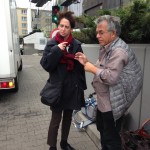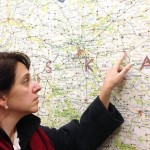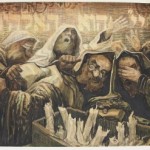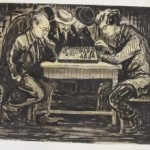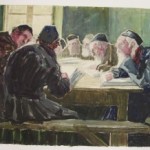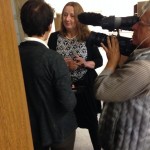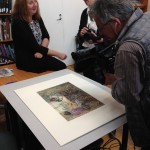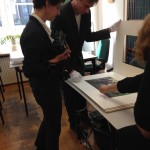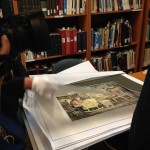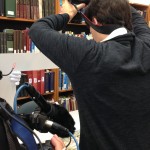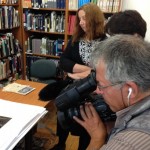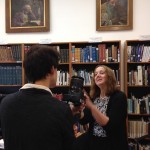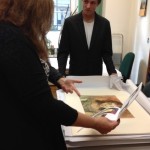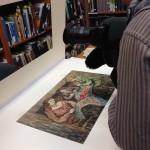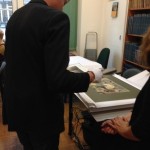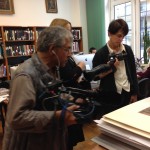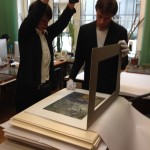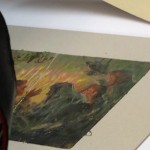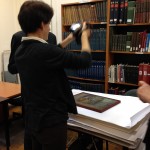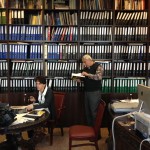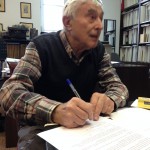Before I left California, I was convinced that my visit to ZIH, the Jewish Historical Institute in Warsaw, would go one of two ways: I would arrive and the sign on the door proclaiming that the museum is closed (which it actually is, until the end of the
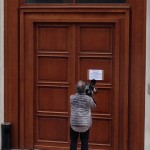 month) would mean no visit for me, OR… everything would go as planned and I would go inside to see the 52 Moshe Rynecki paintings held by the Jewish Historical Institute. I’ll spare you the long drawn out story and drama of my sitting on schpilkas for months, and let you know that yesterday I was given a private viewing of 44 of the paintings! Today I go back to see the rest. [By the way, here’s a photograph of Slawomir Grunberg – a very interesting and successful filmmaker in his own right and, lucky for me, cameraman for my project – filming the sign that says the Institute is closed. Oh, and check him out on Twitter: @SGrunberg]
month) would mean no visit for me, OR… everything would go as planned and I would go inside to see the 52 Moshe Rynecki paintings held by the Jewish Historical Institute. I’ll spare you the long drawn out story and drama of my sitting on schpilkas for months, and let you know that yesterday I was given a private viewing of 44 of the paintings! Today I go back to see the rest. [By the way, here’s a photograph of Slawomir Grunberg – a very interesting and successful filmmaker in his own right and, lucky for me, cameraman for my project – filming the sign that says the Institute is closed. Oh, and check him out on Twitter: @SGrunberg]
We arrived at ZIH a bit before the art curator staff and so took some exterior shots as well as some footage inside the main hallway.
- Getting a wireless mic
- Pointing out MRynecki’s hometown
We met on site with Director Paweł Śpiewak, who took a few moments to speak to me about the institute and its mission. And then we were off to spend several hours with Teresa Śmiechowska and Jakub Bendkowski, both of whom were kind, accommodating, and knowledgeable about the Moshe Rynecki art at ZIH.
Next up? The art itself. First a quick look at the archival storage facility which is, much like other museums, neat, clean, and temperature controlled. Then Jakub brought up the Rynecki artwork into the room where we were to view the pieces. The room was small, and others were working in the space, so in some respects it was not ideal. On the other hand it was an intimate space making it possible for all of us to interact with the pieces so easily.
To say that I am obsessed with finding my great-grandfather’s lost art is probably an understatement. I spend A LOT of time tracking down information about his work. This means that I regularly browse the internet for postings, look for conference papers with images, and request Polish books through my local library. Before arriving at ZIH yesterday, I had a spreadsheet of the institute’s holdings with a corresponding thumbnail sketch of each of the pieces I’d found online and in books. I had done my homework so that when I looked at each piece as it was shown to me, I was familiar with the work. Of course seeing a work in person is far more powerful than looking at a low quality reproduction of the image in a book, but at least one knows what to expect. The first piece came out, I nodded my head, yes, the blind man. The second piece came out, yes, the people painting toys. The third piece came out, some street performers. Nothing surprised me except for the fact that I was standing there, RIGHT THERE, with my great-grandfather’s paintings. It was a profound and important moment for me. I’ve waited YEARS to stand in the same room as his works at ZIH.
But then something happened. Jakub put the next package (all the pieces are wrapped in acid free paper) down, and began to unwrap it and I gasped and leaned forward. “I’ve never seen this piece!” I proclaimed. Slawomir moved closer and focused in on me. I gasped inwards, my breath momentarily caught midstream. I raised my hand to cover my mouth. My eyes grew big. How can it be? How can I have missed this piece? It’s an astounding work. It’s rich in detail, in texture. I may not know this piece, but I instantly recognize the style. There is no doubt in my mind that this is my great-grandfather’s piece.
It is THESE moments that I live for in this project; to find the unknown pieces! And as rare as they are, yesterday there were three such moments. Here they are:
[A note about the Hebrew in the painting at the top from my cousin Nana Meyer: It reads “hu ha-Elohim,” two words from a three word phrase in the liturgy. The complete phrase reads “Adonai hu ha-Elohim” which translates as “Adonai is G-d” or, “The Lord is G-d.” Moshe has only written “hu ha Elohim.” Literally that translates as “G-d is” or “He is G-d.” About the men placing their hands over their eyes, it’s traditional to cover the eyes when reciting the Sh’ma. At the very very very very end of the Yom Kippur service, the Sh’ma is recited followed by reciting “Adonai hu ha-Elohim” seven times. It’s sort of the grand finale to the long day of prayer.]
And as if finding three paintings I didn’t know existed wasn’t enough, yesterday had one other rather large surprise in store for me…. On the backs of several paintings we discovered a tag indicating that my great-grandfather’s work showed at the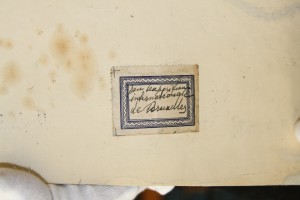 International Exposition in Brussels in 1935. The search now is to figure out how many paintings went to the exposition, how many were sold, and how many returned to Poland. This is the part where I ask you, my followers and supporters, for help…. Anyone have access to archival information with exposition installation photographs? Or perhaps an exhibition catalog showing information about the Polish exhibitors? This stamp I’m showing here at the right is the tag on the back of one of the paintings. [if you have any ideas or answers, please email me: elizabeth@rynecki.org]
International Exposition in Brussels in 1935. The search now is to figure out how many paintings went to the exposition, how many were sold, and how many returned to Poland. This is the part where I ask you, my followers and supporters, for help…. Anyone have access to archival information with exposition installation photographs? Or perhaps an exhibition catalog showing information about the Polish exhibitors? This stamp I’m showing here at the right is the tag on the back of one of the paintings. [if you have any ideas or answers, please email me: elizabeth@rynecki.org]
To say that my day at the Jewish Historical Institute was a good one is really an understatement. I feel jubilant about what I saw and buoyed by the interpersonal connections I’ve made with the staff at the museum. I’m looking forward to returning today. There are 8 pieces I still have not seen and I have a few interview questions to film.
Here are some behind-the-scenes photos by Catherine Greenblatt. I hope these give you a bit more flavor of the day. A shout out to Catherine, who snapped all of these documentation shots. She’s also working the second video camera and the iphone camera. Even more importantly, she is making sure all interviews reflect all of our historical research, and reviewing footage with me at the end of each day. Cathy makes sure I do my daily video log when all I really want to do is be done with the day! Cathy’s POV section has appeared in the last two blogs. There’s another one today below these photos. Be sure to read it! Oh, and you can follow her on Twitter: @catgreenblatt)
Cathy’s POV
Today, we spent the day at ZIH, the Polish acronym for the Jewish Historical Institute. The Institute has collected Jewish artifacts since the Second World War. The building has been closed for some time, since it is undergoing major renovation. When it opens again at the end of the month, it will feature an exhibition called SALVAGE, which will contain two pieces by Moshe Rynecki. Today, we get to see which pieces ZIH has chosen to show and where they hang. But in the meantime, yesterday morning, as we began our morning, we walked into a construction zone: building materials everywhere, paint cans, displaced furniture, plastic buckets, the smell of fresh paint. Historical photographs of the building mounted from the ceiling are blocked by bookcases. Construction workers hammer and drill. Dust is everywhere. Into a small reading room we go, which doubles as temporary office for four ZIH employees; and there, we spend several hours poring over the Moshe Rynecki collection. One of the great anxieties of knowing that such a large number of Rynecki pieces live in someone else’s home is the fear that they are deteriorating, stored in boxes without proper archival protection. But yesterday we were able to let go of that fear entirely. ZIH has cared for its Rynecki collection with utmost care and attention to detail. Many pieces were torn and water damaged when ZIH received them (they are survivors of war, after all), and they have been carefully restored. Everyone wears gloves when touching them, and each piece is protected from the others with acid free paper. Today, we will go to the restoration studio to see how several more Rynecki pieces are being restored. Stay tuned.
